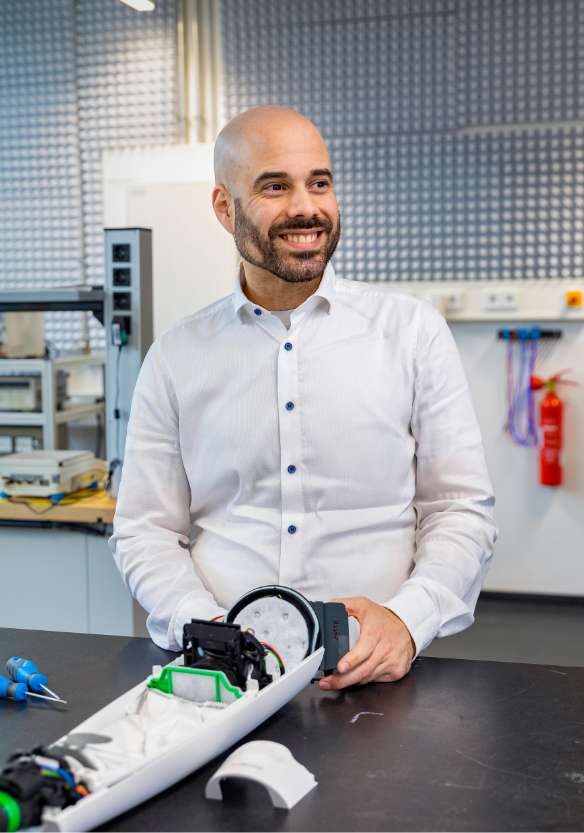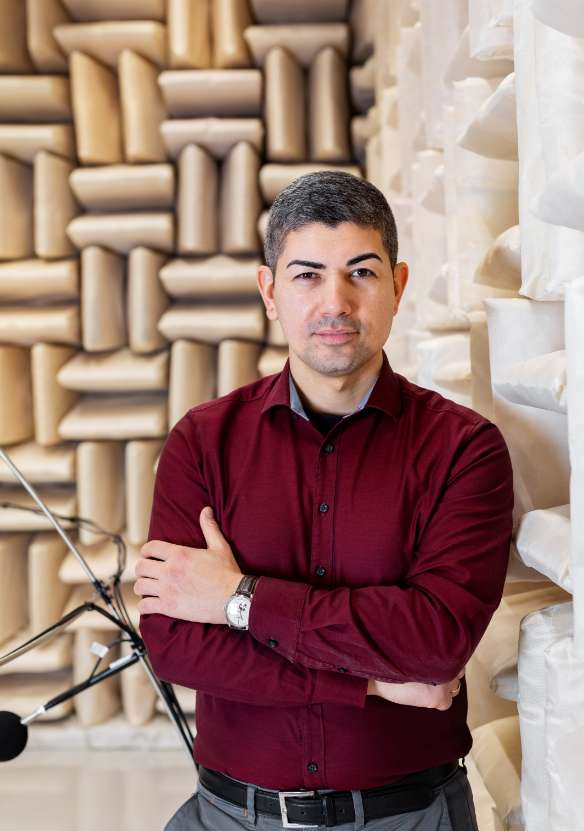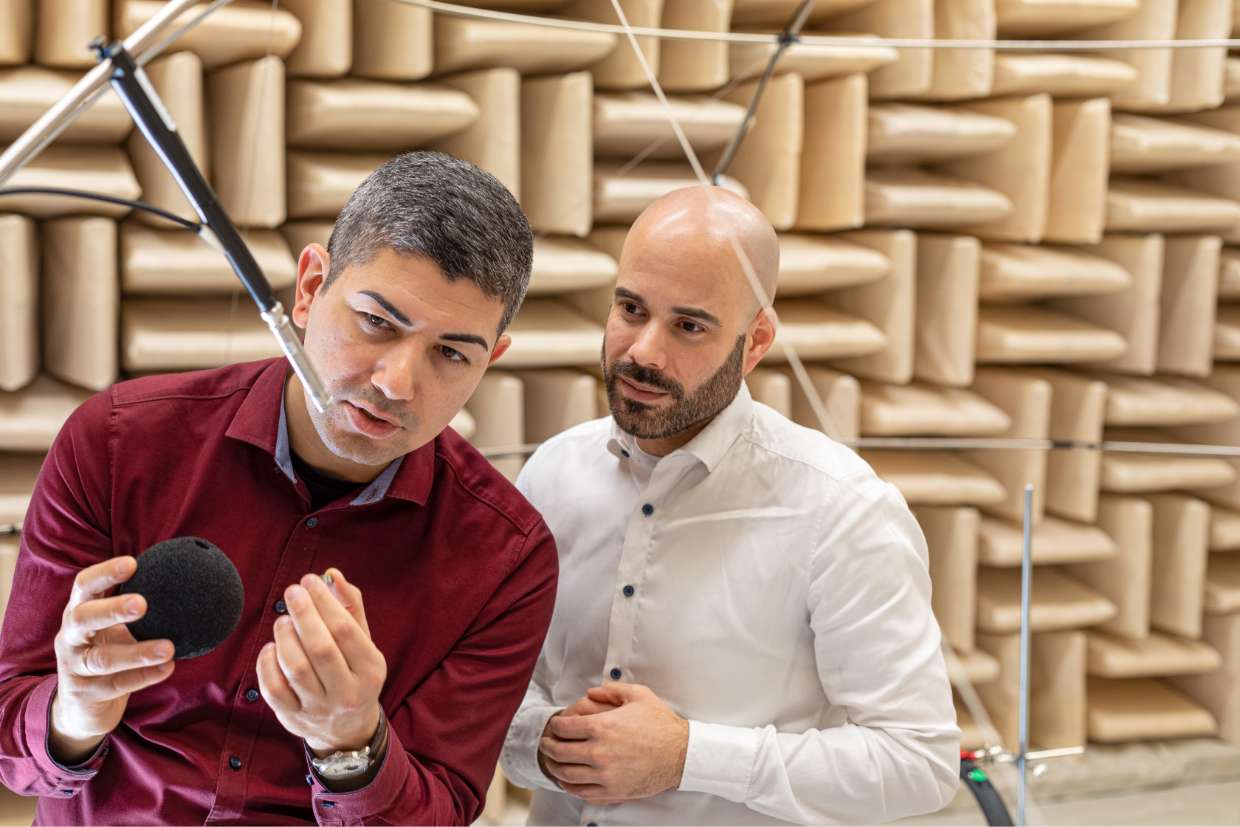Our Financial Year 2022
Group Management Report 2022
Consolidated Financial Statements 2022
The Kobold VK7 has extremely high vacuum power and is yet pleasantly quiet. Vorwerk developed it using agile methods. In a dual interview, product owner Benjamin Fleczok and acoustics engineer Amin Nezami discuss its limitations, simulations and dead ends – and the importance of free space to pursue advances.


Benjamin Fleczok was the senior product owner of the new Kobold VK7 vacuum cleaner. The engineer is 38 years old and has been working at Vorwerk since 2017. He loves ultralight hiking and his cats, Ryu, Makoto and Akuma, who like to introduce themselves in person during video conferences.
Mr. Fleczok, hand on your heart: Are developers allowed to take a wrong turn with you and even end up at a dead end? Or do you prefer those who reach their goal by taking the most direct route?
Fleczok: When it comes to more complex products, the direct route to achieving the goal only exists in theory. With new developments, we rely on making assumptions and form hypotheses. It’s even necessary to take a wrong turn sometimes. That’s how we gain knowledge about the limitations of systems –that’s very important.
Nezami: I can only agree with that. Wrong turns have a bad reputation, but wrongly so. Free spaces and coincidences have played a key role in many a major development in world history.
What was your biggest impasse in developing the new Kobold VK7?
Nezami: As I said, there are no real dead ends with new developments. What there are, however, are plenty of kill-your-darling moments, i.e. situations in which you have to part with cherished ideas or established processes.
Fleczok: That’s right! But the right attitude for facing such situations in a solution-oriented manner has to be developed first.
Nezami: Yes, it’s not all cheers when you have to break new ground. I don’t want to exclude myself from that: I have also mourned the loss of many a darling.
For example? What special challenge did you face?
Nezami: I am a development engineer for acoustics and vibration technology. That means I develop solutions to improve the acoustic behavior of components and systems. This involves reducing unpleasant noises, for example, because our vacuum cleaners need to be as quiet and comfortable as possible for our customers. We initially had a pretty clear acoustic concept for the Kobold VK7. By acoustic concept, we mean that we allow air to move through the vacuum cleaner as unhindered as possible, driven off by the fan, and extract as much noise from it as possible. Suddenly, however, a boundary condition changed and a wall appeared in our concept. We had to think – literally – around this wall. At the end, we were able to use this as momentum and even turn the initial obstacle into an accelerator.
Is it “Chaka” moments like this that drive you in development?
Nezami: Oh yes, because a stand-alone solution that doesn’t have to cope with any constraints is not only unrealistic, but also not very challenging.
How would you describe Vorwerk’s philosophy in the area of research and development? What role does free space play here?
Fleczok: Under the aspect of agile transformation, we are currently strengthening the independent work of the teams, giving them greater freedom and opportunities. Freedom in particular plays a very important role in this. It not only creates trust and an open working atmosphere, but also makes our employees feel even more committed. And that in turn leads to outstanding products.
Nezami: When we started developing the Kobold VK7, this agile methodology was still quite new for Vorwerk. Our team first had to learn how to deal with this freedom. But we proved we can do it and can now look back on a very successful project.

Amin Nezami is principal acoustic engineer. The 37-year-old mechanical engineer has been with Vorwerk since 2016. When he’s not optimizing the Kobold as a development engineer for acoustics and vibration technology, he enjoys his hobbies of photography and barbecuing.

What makes the acoustic concept of the Kobold VK7 so innovative?
Nezami: We were able to resolve a contradiction, because, until now, it was true that a good acoustic concept needs space. But if it has to be small, it causes a lot of pressure loss. We tested many different variants with digital simulations and checked what is even physically feasible. The simulations save us a lot of time and make it possible to try out completely new ideas. This puts more focus on development, and the entire process is quantified. That is enormously helpful. We have thus managed to achieve very good acoustics in a small space and with only low pressure loss. For the customer, this represents great added value: He can vacuum pleasantly quietly, even when the children are sleeping in the same room, to provide a concrete example.
Do you actually get restless when a project runs too smoothly?
Fleczok: No. However, I suspect that such project phases or projects are rare. In every development, there are always points where things go differently than planned. Requirements can change and present new challenges. The important thing here is the mindset, how one reacts to changes, how one takes them in, and how one processes them.
You always wanted to be a DJ? Now is the time! Listen to our vacuum cleaner sounds on vinyl and just put on the model VK119 from 1970. Or the VK130 from 1996? Or start with our new Kobold VK7?
Truly innovative innovations – are they based on individual flashes of inspiration or on outstanding team performance
Fleczok: Clearly on team effort. The idea of the genius being struck by a divine spark is a cliché. Especially with a product as complex as the Kobold VK7, where so many disciplines come together, it takes many perspectives to get to the point. Success here can only be achieved as a team.
Nezami: Yes, definitely. A flash of inspiration like that is quickly extinguished if it isn’t taken up by others and fueled further. After all, it’s not just the concept, the theory that is important for the acoustics of a vacuum cleaner, but also how it is manufactured, for example. The components that are important for acoustics can include many loose parts and foams. Installing them is quite difficult. In interdisciplinary brainstorming sessions, we have always complemented each other wonderfully, pointed out possible difficulties, taken up each other’s ideas and thought them through further.
That means you don’t get inspiration for innovations in the shower, while mountain biking or playing with the kids, but...
Fleczok: ... in a boring way, while attending many workshops with agile teams, where the participants have a lot of freedom to develop and pursue their ideas.
Nezami: Exactly – although you shouldn’t underestimate the inspirational power of a good cheesecake. Joking aside: The best ideas – in terms of those that can be industrialized – actually came to us in rather small and interdisciplinary brainstorming sessions.
What’s next, is there still room for improvement with the Kobold? What other innovations are conceivable?
Fleczok: We already have ideas for future generations of the Kobold. However, we will keep them to ourselves for the time being!

“The idea of the genius being struck by a divine spark is a cliché.”
Benjamin Fleczok, product owner of the Kobold VK7

Mankind has repeatedly made highly amazing inventions around the globe. Benjamin Fleczok and Amin Nezami know all about good ideas and real innovations – what inventions do they think are the best in the world?